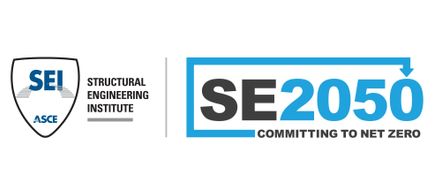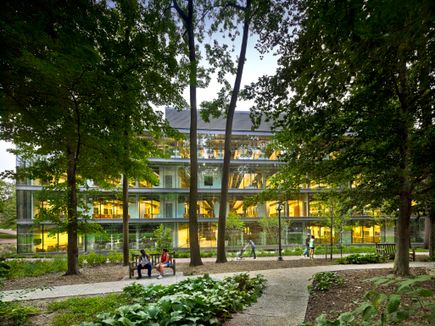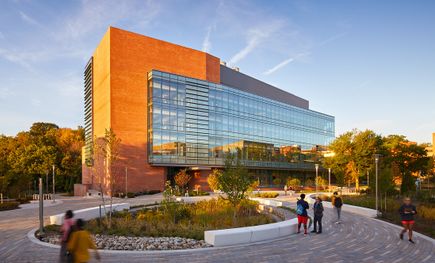Getting to Net Zero
Share

A conversation about the challenges and solutions with two of Ballinger’s engineering leaders
In 2021, the U.S. Green Building Council awarded four Ballinger projects with LEED Gold building certification. LEED certification is a globally recognized symbol of sustainability achievement and leadership, and the 2021 awards are just the latest evidence of Ballinger’s long-term and long-standing focus on creating buildings that are sustainable.
While LEED certification recognizes buildings that are green in a number of ways, it also promotes the notion that architecture and engineering are a critical part of addressing the climate crisis. Buildings account for 39% of annual global greenhouse gas emissions. That statistic is why the American Institute of Architects initiated the 2030 commitment. It is an actionable set of standards for reaching Net Zero emissions in the built environment by the year 2030, and a formal commitment that Ballinger has been a signatory to since 2011.
Getting to Net Zero requires multiple strategies and, as an integrated architecture and engineering firm, Ballinger is in a prime position to explore many of them. As a conversation starter on those explorations, Ballinger’s communications team sat down with two of the firm’s engineering experts to discuss the subject of getting to Net Zero. Jonathan Friedan is a Senior Principal who has been with Ballinger since 1987 and has been a leader in the firm’s sustainability efforts for decades. Dennis Potter is a Principal who, since joining Ballinger in 1996, has become a leader in sustainable systems design. Here is their perspective on getting to net zero.
When did getting to Net Zero crystallize as a specific goal?
Jonathan Friedan: We’ve taken progressively bigger steps towards net zero carbon over the past 20 years, but the realities of getting there are becoming more evident and the realities of not burning fossil fuels on site are becoming more reachable.
Actually, there are two different goals: Net Zero energy and Net Zero carbon. Net Zero carbon is more broadly applicable. Net Zero energy might mean that you can actually produce, at the building, as much energy as you’re using, which in California and some other states is a possibility. But in the northeast, that’s pretty tough. Net Zero carbon, on the other hand, might imply that your renewable energy comes from somewhere else, and you’re using a small amount at the building.
How does Ballinger partner with clients to work toward Net Zero carbon? How has that partnership developed over time?
Friedan: Two of the biggest areas of concentration of our practice are academic science and healthcare. Let’s talk about academic science first. In academic science, the annual cost of energy can be so high that the technologies to significantly reduce it have been clearly the most cost-effective things to be done, so it didn’t take much of a heavy lift to convince our clients in academic science to do what was efficient. But frequently, we’ve taken clients way beyond where they thought they would go, and that’s because we believe this is not an “either/or” situation. What we’ve found helpful is the movement toward systems that give the flexibility needed to address the constant evolution in academic science, and that’s because those systems are those same ones that are going to bring lower energy costs. So that’s how it’s not either/or: it’s not a choice between opposing strategies.
How does collaborating on the goal of Net Zero work in the healthcare sector?
Friedan: There are more challenges for buildings in that sector because there are so many regulatory requirements related to trying to keep people alive – and that’s the priority, of course! Dennis, maybe you can talk a little more about that.
Dennis Potter: It’s true that on the academic side, it’s easier for clients to align with the goal of net zero because these are institutions that want to be leaders in science itself. And so, working together toward net zero can become core to the mission of a building project in academic science. Whereas for hospitals, as Jonathan said, their mission is saving lives and a lot of their resources go to that and less to the way systems are engineered for carbon reduction. I think it’s helpful for clients in that sector to frame the goal in terms of reliability, which is critical for hospitals. What I have come to realize over the last decade is, with climate change, reliability does hinge a little bit on lowering your carbon footprint. Many existing facilities just don’t have the ability to increase capacity to deal with hotter summers or weather events, like flooding, that actually affect their reliability. I think of what happened during Hurricane Sandy, when several New York hospitals had to be evacuated because of power system failures. With new buildings, we have an opportunity to think about sustainability as being a key to reliability.
What is the interplay between architecture and engineering when it comes to the Net Zero goal? How does that interplay benefit clients?
Friedan: A building is not in separate parts. The architecture, the envelope, the glazing, the way the program is laid out in the building, the programmatic decisions that are made in the building, and the systems that we design – they’re all very connected and can all work together toward Net Zero goals, as well as toward the prime functions of the building. We find that the more closely we – design and engineering – can work together, the more easily we can move toward the goal of Net Zero, and the better our buildings are as wonderful places to learn or heal.
Potter: As an AE company, from the engineering perspective not only do we have the ear of our design compadres, but an experience of working together for a long period of time. So our designers understand what’s coming and what we’re going to ask for in order to get as efficient as possible in working toward Net Zero.
Friedan: I think the two forces that drive us as a collaborative team – the desire to innovate in design, and to make sure it works – are key to our approach.
What possibilities and challenges do you see on the horizon, in terms of getting to Net Zero?
Friedan: I think in the short term, the most feasible path where you need heat, like in the northeast, is to electrify, and to use heat pumps and geothermal. You can produce heat electrically very efficiently and cost effectively, compared to burning fossil fuels. Some clients are completely electrifying, getting rid of their fossil fuel reliance. But not everybody can afford that. Huge infrastructures have been built that rely on fossil fuels, especially in the healthcare world, but also in the university world. I think we’re in a position now where we may start down a road and do certain things with the understanding that there may be a fork in the road, in the 10- to 20-year time frame.
We’re just going through that with one of our university clients, who has about 17 million square feet of campus. We did a screening assessment where we looked at future technologies and what their horizon was for development, how likely that development was, and where it stands now. And out of that assessment we’ve created three scenarios for the university, going from complete electrification to maintaining a significant amount of their steam infrastructure. We’re in the middle of the process, but what I think will come out is that we’ll see some pivot points in between now and 2050, when they can decide either, yes, they’ll start complete elimination of their steam infrastructure, or no, they’re going to keep the core steam infrastructure that’s there at that point and convert it to green.
If people reading this have one takeaway about getting to Net Zero, what would you want it to be?
Potter: I think that initially, there’s often a feeling, on the part of the client, that if they’re going towards net zero, they’re paying for it, and paying at first cost. It’s a mental hurdle: Net Zero is just one more piece that we’re adding to the building requirements. And I know that it’s easier for a client to say, all we can afford to do is what the building code requires. But code is not going to get you toward Net Zero. Code gets you baseline. Baseline today is much better than baseline 10 years ago, but it’s still not going to get you toward the global goal of halting warming at two degrees Celsius. So, the mental hurdle we help clients with is that we’re going above and beyond the code because you can work toward that Net Zero goal and – at the same time – have a building with lower operating costs. At the end of day, the Net Zerogoal is going to help the project.



